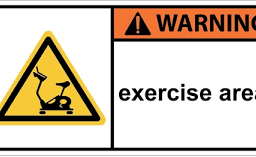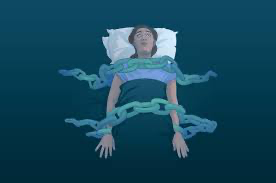
Understanding Sleep Paralysis: Unraveling the Mystery of Dreams
Discover the intriguing world of sleep paralysis, a fascinating phenomenon that bridges the realms of dreams and wakefulness. In this post, we’ll unravel the mysteries surrounding this phenomenon, shedding light on its causes, experiences, and coping strategies. Join us as we delve into the captivating intersection of science and the supernatural, where dreams haunt reality, and consciousness takes on a surreal journey of its own.
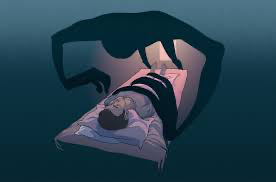
Have you ever found yourself trapped in a state of temporary paralysis, unable to move or scream, as if caught between a dream and reality? If so, you might have experienced the perplexing phenomenon known as sleep paralysis. This eerie occurrence has puzzled and terrified people for centuries, blending elements of the supernatural with the science of sleep.
Sleep Paralysis: The Nighttime Struggle:
Imagine waking up in the middle of the night, your mind awakened but your body immobile, as if held captive by invisible restraints. This is the essence of sleep paralysis—a curious state where your consciousness is alert, but your body remains temporarily frozen. It is during this liminal period between sleep and wakefulness that sleep paralysis takes hold, leaving you vulnerable to a rollercoaster ride of hallucinations and unsettling sensations.
The Dark Side of Dreams:
One of the most haunting aspects of sleep paralysis is the vivid hallucinations that often accompany it. These hallucinations can range from eerie whispers and eerie shadows to full-blown apparitions of otherworldly beings. Some report encountering malevolent entities perched upon their chests, casting a suffocating weight that adds to the sense of terror. These hallucinations can be so vivid that differentiating between dream and reality becomes an arduous task.

A Dance with the Demonic or a Trick of the Mind?
Across cultures, this phenomenon has been attributed to a myriad of supernatural entities. From the Old Hag in European folklore to the “Jinn” in Islamic traditions, various mythologies have sought to explain this uncanny phenomenon. However, science offers us a different perspective. This is thought to occur due to a disruption in the sleep cycle, specifically during the rapid eye movement (REM) stage, where most dreaming takes place. During REM sleep, our muscles are naturally immobilized to prevent us from physically acting out our dreams. It occurs when this muscle atonia continues beyond the REM stage, momentarily trapping us in a state of paralysis while our minds awaken.
Unraveling the Triggers:
Several factors can contribute to the onset of sleep paralysis:
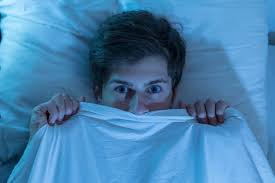
1. Sleep Deprivation: Irregular sleep patterns and chronic sleep deprivation can heighten the likelihood of experiencing sleep paralysis episodes.
2. Sleep Disorders: Conditions like narcolepsy, insomnia, and sleep apnea can disrupt the natural sleep cycle and increase the occurrence this condition.
3. Stress and Anxiety: High levels of stress and emotional distress can trigger sleep paralysis episodes, likely due to their impact on sleep quality.
4. Sleeping Positions: Surprisingly, research suggests that sleeping on your back (the supine position) can increase the chances of experiencing sleep paralysis. It is believed that this position may cause increased chest pressure and breathing difficulties, potentially leading to an episode.
Coping Strategies and Empowering Techniques:
While sleep paralysis can be an unnerving experience, there are strategies to help navigate and mitigate its impact:

1. Relaxation Techniques: Practicing relaxation exercises such as deep breathing, meditation, or progressive muscle relaxation can help calm the mind and body before sleep, reducing the likelihood of episodes.
2. Establishing a Sleep Routine: Maintaining a consistent sleep schedule, creating a comfortable sleep environment, and adopting healthy sleep habits can promote better sleep quality and decrease the occurrence of sleep paralysis.
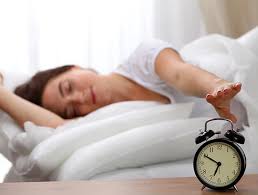
3. Educate Yourself: Understanding the science behind sleep paralysis can alleviate fear and anxiety. Knowledge empowers you to recognize when an episode occurs, reducing the panic that often accompanies it.
4. Seek Support: Engage in online forums or support groups where individuals share their experiences with sleep paralysis. Connecting with others who have gone through similar experiences can provide a sense of validation and support, making the encounters with sleep paralysis feel less isolating.

5. Reduce Stress: Incorporate stress management techniques into your daily routine. Engaging in activities that promote relaxation, such as yoga, exercise, or journaling, can help reduce overall stress levels and potentially lessen the frequency of episodes.
6. Sleep Position Modification: If you consistently experience sleep paralysis while sleeping on your back, try experimenting with different sleep positions. Sleeping on your side or stomach may alleviate the pressure on your chest and reduce the likelihood of an episode.
7. Consult a Professional: If sleep paralysis significantly affects your quality of life or occurs alongside other sleep disorders, it is advisable to seek guidance from a sleep specialist or medical professional. They can evaluate your symptoms, provide a proper diagnosis, and suggest potential treatments or therapies tailored to your specific needs.
8. Lucid Dreaming: Some individuals have found success in practicing lucid dreaming techniques as a way to navigate and control their experiences during sleep paralysis. Lucid dreaming involves becoming aware that you are dreaming while in the dream state, which can provide a sense of empowerment and control. Exploring resources and techniques related to lucid dreaming may offer a unique approach to dealing with episodes.
9. Cognitive Behavioral Therapy (CBT): CBT techniques can be helpful in managing the anxiety and fear associated with sleep paralysis. Working with a therapist trained in CBT can provide valuable tools and strategies to reframe negative thought patterns, reduce anxiety, and develop coping mechanisms specific to the condition.
10. Mindfulness and Meditation: Practicing mindfulness and meditation can foster a sense of calm and grounding, both of which can be beneficial when experiencing sleep paralysis. By focusing on the present moment and observing your thoughts and sensations without judgment, you can cultivate a sense of detachment from the fear and anxiety often associated with sleep paralysis.
11. Sleep Hygiene: Prioritizing good sleep hygiene is crucial for overall sleep health and can potentially reduce the occurrence of the phenomenon. Establish a relaxing bedtime routine, create a sleep-friendly environment, avoid stimulants close to bedtime, and limit exposure to electronic devices before sleep to promote a restful night’s sleep.
12. Keep a Sleep Journal: Maintaining a sleep journal can help identify patterns and triggers related to the episodes. Note the frequency, duration, and any potential factors that may have contributed to each episode. This information can assist you in understanding your unique experiences and guide your efforts in managing and preventing future episodes.
Embracing the Extraordinary:
While the condition can be distressing, it’s essential to remember that it is a relatively common phenomenon with scientific explanations. By demystifying its origins and implementing coping strategies, we can reclaim control over our experiences and view sleep paralysis as an extraordinary quirk of our remarkable minds.

So, the next time you find yourself caught in the ethereal realm between dreams and wakefulness, take a deep breath and remind yourself that it is a temporary state—one that reveals the extraordinary intricacies of our brain’s sleep architecture. Embrace the mystery, educate yourself, and explore the wonders that unfold within the depths of our slumbering minds. Sleep paralysis reminds us that the boundaries between reality and imagination can blur, offering a glimpse into the extraordinary tapestry of human consciousness. Remember, while it can be unsettling, it is typically harmless and not a sign of an underlying health issue. By implementing these coping strategies and seeking support when needed, you can navigate through the episodes with resilience and minimize their impact on your overall well-being.
Disclaimer: The information provided in this content is for general informational purposes only. It is not intended as medical or healthcare advice, diagnosis, or treatment. Always seek the advice of a qualified healthcare professional with any questions you may have regarding a medical condition or healthcare decisions.


